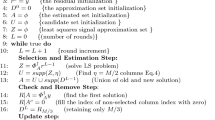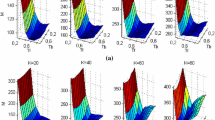Abstract
Compressed Sensing (CS), as a promising paradigm for acquiring signals, is playing an increasing important role in many real-world applications. One of the major components of CS is sparse signal recovery in which greedy algorithm is well-known for its speed and performance. Unfortunately, in many classic greedy algorithms, such as OMP and CoSaMP, the real sparsity is a key prior information, but it is blind. In another words, the true sparsity is not available for many practical applications. Due to this disadvantage, the performance of these algorithms are significantly reduced. In order to avoid too much dependence of classic greedy algorithms on the true sparsity, this paper proposed an efficient reconstruction greedy algorithm for practical Compressed Sensing, termed stepwise optimal sparsity pursuit (SOSP). Differs from the existing algorithms, the unique feature of SOSP algorithm is that the assumption of sparsity is needed instead of the true sparsity. Hence, the limitations of sparsity in practical application can be tackled. Based on an arbitrary initial sparsity satisfying certain conditions, the SOSP algorithm employs two variable step sizes to hunt for the optimal sparsity step by step by comparing the final reconstruction residues. Since the proposed SOSP algorithm preserves the ideas of original algorithms and innovates the prior information of sparsity, thus it is applicable to any effective algorithm requiring known sparsity. Extensive experiments are conducted in order to demonstrate that the SOSP algorithm offers a superior reconstruction performance in terms of discarding the true sparsity.











Similar content being viewed by others
References
Ambat SK, Chatterjee S, Hari KVS (2014) A committee machine approach for compressed sensing signal reconstruction. IEEE Trans Signal Process 62(7):1705–1717
Baraniuk R (2011) More Is less: Signal processing and the data deluge. Science 331(6018):717–719
Baraniuk R, Steeghs P (2007) Compressive radar imaging. In: 2007 IEEE radar conference, pp 128–133
Budillon A, Evangelista A, Schirinzi G (2011) Three-dimensions SAR focusing from multipass signals using compressive sampling. IEEE Trans Geosci Remote Sens 49(1):488–499
Candes EJ (2008) The restricted isometry property and its implications for compressed sensing. Comptes Rendus Mathematique 346(9):589–592
Candes EJ, Tao T (2005) Decoding by linear programming. IEEE Trans Inf Theory 51(12):4203–4215
Candes EJ, Wakin M (2008) An introduction to compressive sampling. In: IEEE signal processing magazine, pp 21–30
Candes EJ, Romberg J, Tao T (2006) Robust uncertainty principles: Exact signal reconstruction from highly incomplete frequency information. IEEE Trans Inf Theory 52(2):489–509
Dai W, Milenkovic O (2009) Subspace pursuit for compressive sensing signal reconstruction. IEEE Trans Inf Theory 55(5):2230–2249
Do TT, Gan L, Nguyen N, Tran TD (2008) Sparsity adaptive matching pursuit algorithm for practical compressed sensing. In: Asilomar conference on signals, systems, and computers, pp 581–587
Donoho D (2006) Compressed sensing. IEEE Trans Inf Theory 52:1289–1306
Duarte M, Davenport MA, Takhar D, Laska J, Sun T, Kelly K, Baraniuk R (2008) Single-pixel imaging via compressive sampling. IEEE Signal Proc Mag 25(2):83
Fang L, Li S, McNabb RP, Nie Q, Kuo AN, Toth CA, Izatt JA, Farsiu S (2013) Fast acquisition and reconstruction of optical coherence tomography images via sparse representation. IEEE Trans Med Imaging 32(11):2034–2049
Hegde C, Sankaranarayanan AC, Yin W, Baraniuk R (2015) A convex approach for learning near-Isometric linear embeddings. IEEE Trans Signal Process 63(22):6109–6121
Kajbaf H, Case JT, Yang Z, Zheng YR (2013) Compressed sensing for SAR-based wideband three-dimensional microwave imaging system using non-uniform fast fourier transform. IET Radar Sonar Navig 7(6):658–670
Kowalski M, Piszczek M, Szustakowski M, Ciurapinski W (2012) Single-pixel camera simulation tool and the first results of analysis of image quality. In: Annals of DAAAM for 2012 & proceedings of the 23rd international DAAAM symposium, vol 23, no 1, ISSN 2304–1382
Lawrie BJ, Pooser RC (2013) Toward real-time quantum imaging with a single pixel camera. Opt Express 21(6):7549–7559
Lingala SG, Jacob M (2013) Blind compressive sensing dynamic MRI. IEEE Trans Med Imaging 32(6):1132–1145
Liu E, Temlyakov VN (2012) The orthogonal super greedy algorithm and applications in compressed sensing. IEEE Trans Inf Theory 58(4):2040–2047
Liu P, Kie B (2014) Eom compressive sensing of noisy multispectral images. IEEE Geosci Remote Sens Lett 11(11):1931–1935
Lustig M, Donoho D, Pauly J (2007) Sparse MRI:the application of compressed sensing for rapid MR imaging. Magn Reson Med 58(6):1182–1195
Lustig M, Donoho D, Santos J, Pauly J (2008) Compressed sensing MRI. IEEE Signal Proc Mag 25(2):72–82
Mallat SG, Zhang Z (1993) Matching pursuits with time-frequency dictionaries. IEEE Trans Signal Process 41(12):3397–3415
Mangia M, Pareschi F, Cambareri V et al (2017) Rakeness-based design of low-complexity compressed Sensing. In: IEEE transactions on circuits and systems I: Regular Papers, pp 1–13
Mota JFC, Xavier J, Aguiar PMQ, Puschel M (2012) Distributed basis pursuit. IEEE Trans Signal Process 60(4):1942–1956
Needell D, Tropp J (2009) CosaMP: Iterative signal recovery from incomplete and inaccurate samples. Appl Comput Harmon Anal 26(3):301–321
Needell D, Vershynin R (2010) Signal recovery from incomplete and inaccurate measurements via regularized orthogonal matching pursuit. IEEE J Sel Top Sign Proces 4(2):310–316
Petrovici MA, Coltuc D, Datcu M, Vasile T (2015) Rate-distortion performance of compressive sensing in single pixel camera. In: 2015 IEEE international conference industrial technology (ICIT), pp 1747–1751
Romberg J (2008) Compressive sensing. IEEE Signal Proc Mag, pp 118–121
Rossi M, Haimovichn AM, Eldar YC (2014) Spatial compressive sensing for MIMO radar. IEEE Trans Signal Process 62(2):419–430
Sankaranarayanan AC, Xu L, Studer C, Li Y, Kelly K, Baraniuk R (2015) Video compressive sensing for spatial multiplexing cameras using motion-Flow models. SIAM J Imag Sci 8(3):1489– 1518
Shir azinia A, Chatterjee S, Skoglund M (2014) Joint source-channel vector quantization for compressed sensing. IEEE Trans Signal Process 62(14):3667–3681
Takhar D, Laska J, Wakin M, Duarte M, Baron D, Sarvotham S, Kelly K, Baraniuk R (2006) A new compressive imaging camera architecture using optical-domain compression. IS&T/SPIE Computational Imaging IV, vol 6065
Tropp J (2004) Greed is good: Algorithmic results for sparse approximation. IEEE Trans Inf Theory 50(10):2231–2242
Tropp J, Gilbert A (2007) Signal recovery from random measurements via orthogonal matching pursuit. IEEE Trans Inf Theory 53(12):4655–4666
Wang L, Lu K, Liu P (2015) Compressed sensing of a remote sensing image based on the priors of the reference image. IEEE Geosci Remote Sens Lett 12(4):736–740
Yang J, Thompson J, Huang X, Jin T, Zhou Z (2013) Random-frequency SAR imaging based on compressed sensing. IEEE Trans Geosci Remote Sens 51(2):983–994
Yuan J, Usman A, Reid SA et al (2017) Three-dimensional black-blood T2 mapping with compressed sensing and data-driven parallel imaging in the carotid artery. Magn Reson Imaging 37:62–69
Zeng WJ, So HC, Jiang X (2016) Outlier-robust greedy pursuit algorithms in lp-space for sparse approximation. IEEE Trans Signal Process 64(1):60–75
Zhu X, Bamler R (2010) Tomographic SAR inversion by L1-Norm Regularizationthe compressive sensing approach. IEEE Trans Geosci Remote Sens 48(10):3839–3846
Acknowledgment
The authors would like to thank their colleagues for many useful comments. In particular, they are grateful to Xuefei Bai of Shanxi University for many discussions on the OMP and CoSaMP code. This work was supported by the National Science Foundation of China (No. 61273294) and Youth Foundation of Shanxi Province, China (201601D202040). F. Hao’s work was supported by the Fundamental Research Funds for the Central Universities, China (Grant No. GK201703059) and the Natural Science Foundation for Young Scientists of Shanxi Province, China (Grant No. 2015021102). D.S. Park’s work was supported by Basic Science Research program through the National Research Foundation of Korea (NRF) funded by the Ministry of Education (No. NRF-2017R1A2B1008421).
Author information
Authors and Affiliations
Corresponding author
Rights and permissions
About this article
Cite this article
Guo, H., Han, S., Hao, F. et al. SOSP: a stepwise optimal sparsity pursuit algorithm for practical compressed sensing. Multimed Tools Appl 78, 3–26 (2019). https://doi.org/10.1007/s11042-017-4920-6
Received:
Revised:
Accepted:
Published:
Issue Date:
DOI: https://doi.org/10.1007/s11042-017-4920-6




